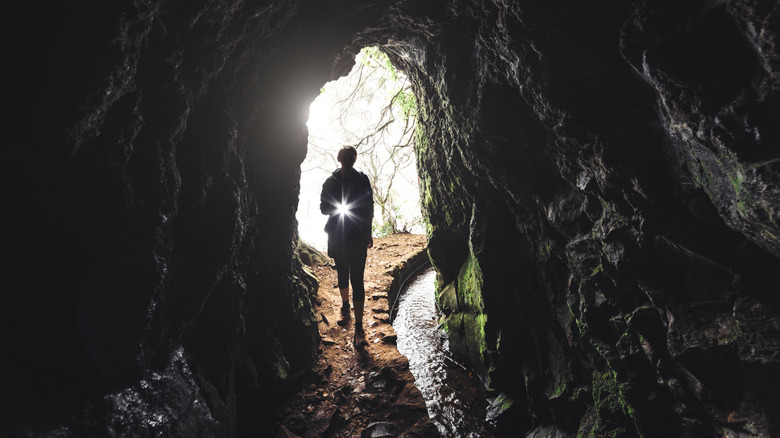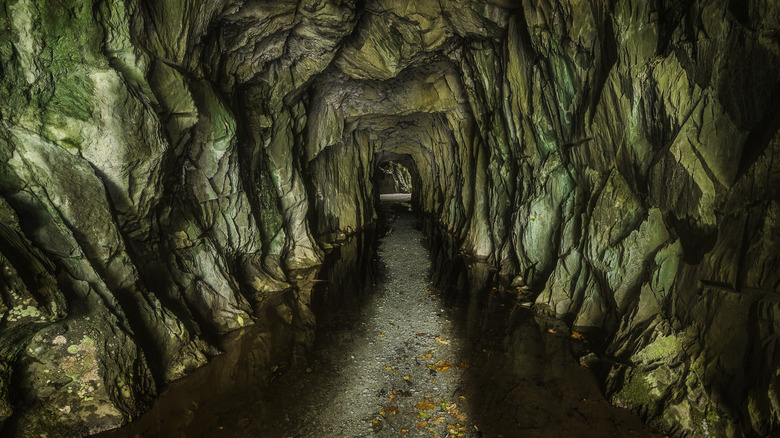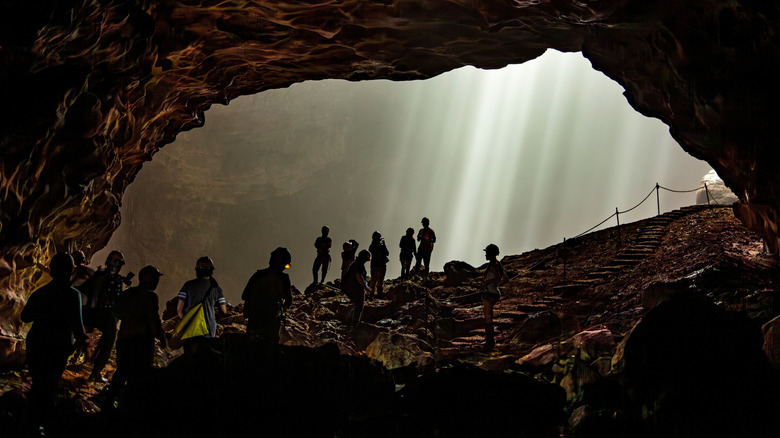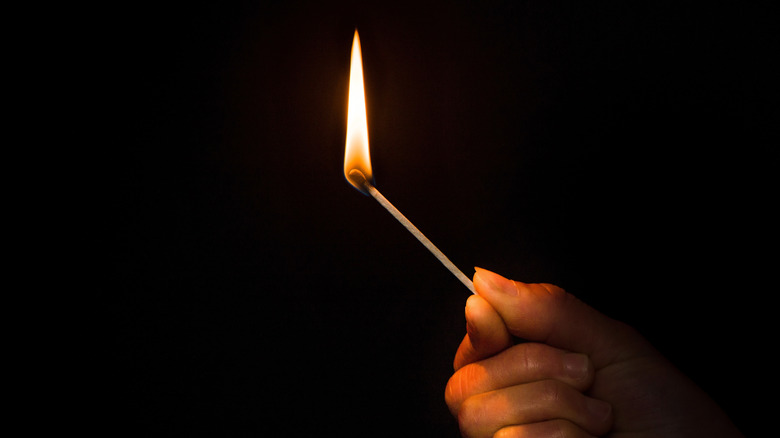The Hidden Danger That'll Make You Think Twice About Caving
Caving is a thrilling endeavor, but it probably won't surprise you to learn that it also carries a great deal of potential danger. Caves are filled with dark corners and tight spaces that create a high risk for falls and entrapment, not to mention the fact that you could run into a massive bat colony if you haven't done your research. But the scariest threat lurking inside caves is invisible, and not just because it's dark in there. Climbing into the wrong cave could cost a person their life thanks to an exceedingly common, yet very dangerous gas.
Carbon dioxide might not sound scary at first. After all, it's all over the place and you exhale it every time you breathe out. Breathing it in, however, can be very dangerous because the more CO2 there is in the air, the less oxygen there is, creating a serious risk for asphyxiation. The air we breathe contains 0.036% CO2, but in tightly enclosed caverns where air flow is poor, those levels can rise much higher. If air contains more than 1% CO2, it is known as "foul air" or "bad air," and it is arguably the greatest danger to cavers. However, foul air isn't a universal problem. It only forms in certain caves, due to a very specific set of geological conditions.
How carbon dioxide forms in caves
Carbon dioxide is a core feature of caves beginning with their formation. The process begins when rainwater mixes with CO2, turning the water acidic, as the water seeps through the soil, it eats away at the rock below to form a hollowed-out cavern. This CO2 comes mainly from the decay of plants and other materials in soil. Some soils can contain as much as 12% CO2. This process continues indefinitely as rain falls on the soil above the cave and seeps through it, collecting CO2 along the way. This steadily fills the cave air with more and more CO2. Some CO2 also comes from the composition of Earth's atmosphere, as well as greenhouse emissions and volcanic emissions in the nearby air.
Carbon dioxide is 1.57% heavier than nitrogen and 1.38% heavier than oxygen, the two primary elements that make up the air we breathe. Since narrow cave chambers tend to have very poor air flow, the air within them becomes still, allowing that CO2 to sink into the deepest levels of the cavern, steadily building up a higher and higher concentration. As CO2 sinks, it pushes the less dense nitrogen and oxygen upwards, creating a pocket of unbreathable air. Due to the fact that CO2 sinks, the odds of encountering foul air become greater and greater the deeper into a cave you go.
The terrifying consequences of carbon dioxide in caves
Simply put, you do not want to find yourself in a cave with foul air. Our lungs are made to breathe air with only very small amounts of carbon dioxide. The air at our level is just 0.036% CO2, and 0.5% is generally recognized as the safety limit for long-term exposure. Once you reach 1.0% concentration, you'll start to feel tired and weak, legs wobbling in confusion. Anything beyond that is considered foul air, and it only takes 2.0% CO2 concentration for the gas to make your body too acidic, wreaking havoc on your metabolism and quickly sapping your energy. Beyond 10% concentration, you can only take a few minutes of exposure before passing out and suffocating.
Foul air has tragically taken the lives of numerous cavers. A particularly notable case occurred at Peak Cavern, one of the most famous caves in England, where, in 1959, a 20-year-old college student named Neil Moss joined seven friends on a journey half a mile into the cave. While trying to crawl through a narrow passage, Moss became stuck. A rescue team rushed to the scene, but they were unable to free Moss, partly because the intense CO2 exposure made him delirious and uncooperative with the rescuers. At the same time, the foul air began affecting the rescuers and causing some of them to pass out. Moss did not survive, and the passage was sealed off with his body still jammed between the rocks.
Checking for foul air using the flame test
Every caver should be aware of the dangers posed by foul air, and should research any caves they plan on exploring ahead of time to find out if they are known to have high carbon dioxide levels or have a history of associated accidents. Another step that many cavers use to determine whether a particular passage is safe is something called the naked flame test. The naked flame test entails lighting a match, candle, or butane lighter to test the air quality in a cave. Fire is a chemical reaction created by the combination of heat, a fuel source, and oxygen, so if the air is low in oxygen, a flame cannot ignite.
It's wise to carry some matches or a lighter whenever you go caving, and if you start to feel any shortness of breath, try lighting it to determine whether the air around you is the problem. Matches and candles will not light if the O2 concentration is 15% or lower, and a butane lighter will go out at 14.25% O2 concentration. Some cavers even carry a carbide lamp with them, which features an open flame powered by acetylene gas.
The naked flame test doesn't actually test for CO2 in the air, but rather for the absence of the O2 it displaces. If a flame fails, you should leave the area and find a well-ventilated space to recover your breath. The general wisdom is: when in doubt, get out.



